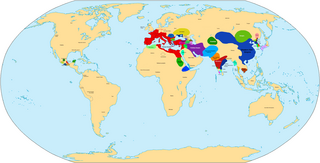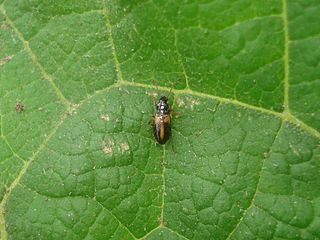
AD 1 (I), 1 AD or 1 CE is the epoch year for the Anno Domini calendar era. It was the first year of the Common Era (CE), of the 1st millennium and of the 1st century. It was a common year starting on Saturday or Sunday, a common year starting on Saturday by the proleptic Julian calendar, and a common year starting on Monday by the proleptic Gregorian calendar. In its time, year 1 was known as the Year of the Consulship of Caesar and Paullus, named after Roman consuls Gaius Caesar and Lucius Aemilius Paullus, and less frequently, as year 754 AUC within the Roman Empire. The denomination "AD 1" for this year has been in consistent use since the mid-medieval period when the anno Domini (AD) calendar era became the prevalent method in Europe for naming years. It was the beginning of the Christian/Common era. The preceding year is 1 BC; there is no year 0 in this numbering scheme. The Anno Domini dating system was devised in AD 525 by Dionysius Exiguus.
Year 1 BC was a common year starting on Friday or Saturday of the Julian calendar and a leap year starting on Thursday of the Proleptic Julian calendar. It is also a leap year starting on Saturday, in the Proleptic Gregorian calendar. At the time, it was known as the Year of the Consulship of Lentulus and Piso. The denomination 1 BC for this year has been used since the early medieval period, when the Anno Domini calendar era became the prevalent method in Europe for naming years. The following year is 1 AD in the widely used Julian calendar, which does not have a "year zero".

Dionysius Exiguus was a 6th-century monk born in Scythia Minor. He was a member of a community of Scythian monks concentrated in Tomis, the major city of Scythia Minor. Dionysius is best known as the inventor of Anno Domini (AD) dating, which is used to number the years of both the Gregorian calendar and the (Christianised) Julian calendar. Almost all churches adopted his computus (calculation) for the dates of Easter.
Dionysius Exiguus's Easter table was constructed in the year 525 by Dionysius Exiguus for the years 532–626. He obtained it from an Easter table attributed to Patriarch Cyril of Alexandria for the years 437–531. The latter was constructed around the year 440 by means of extrapolation from an Alexandrian Easter table constructed around the year 390 by Patriarch Theophilus of Alexandria. The great historical importance of Dionysius' Easter table is twofold:
- From this Easter table Bede's Easter cycle would ultimately be developed by means of which all future Julian calendar dates of Easter Sunday were determined ;
- With his Easter table Dionysius introduced in passing the Christian era which would be developed into a full system for dating historical events by Bede two centuries later.

Acupalpus is a genus of insect-eating beetle species. Its representatives are found across Europe, Asia, and North America.
Carabus exiguus is a species of black-coloured ground beetle in the Carabinae subfamily that is endemic to China.
Acupalpus alluaudianus is an insect-eating beetle of the genus Acupalpus.
Acupalpus alternans is an insect-eating beetle of the genus Acupalpus.
Acupalpus antongilensis is an insect-eating ground beetle of the genus Acupalpus.

Acupalpus brunnipes is a ground beetle in the family Carabidae, found in the Palearctic, in northern and western Europe, Greece, and North Africa. It typically lives among moss and litter near water. Like most ground beetles, Acupalpus brunnipes is a predator.
Acupalpus carus is a black coloured insect-eating ground beetle of the Acupalpus genus which can be found in Canada and the United States.
Acupalpus convexulus is an insect-eating ground beetle of the Acupalpus genus.
Acupalpus flaviceps is an insect-eating ground beetle of the Acupalpus genus.

Acupalpus flavicollis is a species of ground beetle in the family Carabidae.
Acupalpus flavilimbus is an insect-eating ground beetle of the Acupalpus genus.
Acupalpus inornatus is an insect-eating ground beetle of the Acupalpus genus. It is 3.5 to 4.2 millimeters long and reddish-brown or yellowish in color. It is shiny and iridescent.
Acupalpus pauperculus is a species of ground beetle in the family Carabidae. It is found in North America.

Acupalpus testaceus is a species of ground beetle in the family Carabidae. It is found in North America.
Acupalpus pumilus is a species of ground beetle in the family Carabidae. It is found in North America.






